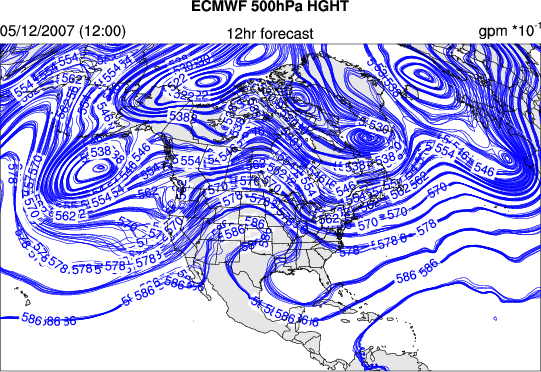NCL Home>
Application examples>
Models ||
Data files for some examples
Example pages containing:
tips |
resources |
functions/procedures
NCL Graphics: TIGGE Project

TIGGE Project
TIGGE, the THORPEX Interactive Grand Global Ensemble, is a key component of THORPEX:
a World Weather Research Programme to accelerate the improvements in the accuracy of
1-day to 2 week high-impact weather forecasts for the benefit of humanity. Centralized
archives of ensemble model forecast data, from many international centers, will be used
to enable extensive data sharing and research.
The following examples show how to plot multiple ensemble members on one plot (a spaghetti plot),
how to calculate an ensemble average, and how to calculate a grand ensemble from data on 5
different grids (from 5 different modeling centers).
All TIGGE data files are in GRIB1/GRIB2 format. In the examples below, the file
extension ".grib2" is appended to each TIGGE file. NCL recognizes the
following case-insensitive extensions for GRIB files: ".grb" , ".grib",
".grb1", ".grib1", ".grb2", "grib2". The actual file need not have the specified
GRIB extension. By default, NCL will look for the exact file name
as specified in the addfile function. If that file name is not found, NCL
will look for the file name without the file extension and treat it
as a GRIB file.
Note that users can use ncl_filedump to look at the contents of a GRIB1/GRIB2 file.
The output from using ncl_filedump on a ecmf TIGGE file can be found
here.

 tigge_1.ncl
tigge_1.ncl:
Demonstrates how to draw a spaghetti plot showing Z500 from the
first 10 ECMWF ensemble members for a 12-hr forecast. The key to creating a spaghetti
plot is to set
gsnDraw and
gsnFrame to False, and to use the
overlay function to overlay one plot on top of another. After all the plots
are overlaid,
draw and
frame must be called. In this
example, a map is created first with titles, and then 10 contour fields (from the first 10
ensemble members) are overlaid on the map.
For the second plot, an ensemble average is created by using
dim_avg_Wrap to average across the 51 ECMWF
ensemble members. The variance (or spread) amongst the individual ensemble members is also calculated by using
dim_variance_Wrap. gsn_csm_contour_map_overlay is
used to overlay the mean plot over the variance plot.
 tigge_2.ncl
tigge_2.ncl:
A spaghetti plot showing the 564dm (@500hPa) contour from all 51 ECMWF
ensemble members (blue lines) and the ensemble average of the 51 members
(thick red line).

 tigge_3.ncl
tigge_3.ncl:
A spaghetti plot showing the T@500hPa ensemble average from each of the
5 modeling centers participating in the TIGGE project.
For the second plot, the 5 modeling center ensembles are averaged to form a grand ensemble. The variance (or spread)
amongst the five ensemble members is also calculated by using dim_variance_Wrap.
Four
of the ensembles (babj, ecmf, egrr, and kwbc) are regridded to the rjtd ensemble resolution for
this calculation. (The rjtd ensemble resolution was chosen because it has the lowest
resolution.) The function linint2_Wrap was used for the regridding. Note
that linint2_Wrap expects the input/output latitude/longitude grids to be
monotonically increasing. The input/output latitudes must run from south->north, and the longitudes
must run from west->east. The ecmf, babj, kwbc, and rjtd grids had latitudes that ran from
north->south, and they were easily flipped by using the syntax "::-1" when the data were being
read into NCL.
The grand ensemble formed in this example was calculated by averaging the 5 modeling centers
ensemble averages. This method ensures that each modeling center's ensemble receives equal weight
in the grand ensemble. Another method used to form a grand ensemble is to average across each
individual ensemble member from each of the 5 modeling centers. In this case, that would result
in averaging 15 (babj)+ 51 (ecmf)+ 24 (egrr)+ 21 (kwbc)+ 51 (rjtd) = 162 ensemble members. Note
that this method results in those models with the largest number of ensemble members (ecmf/rjtd)
having more of an effect on the grand ensemble than those models that have fewer ensemble members
(babj/egrr/kwbc).
 tigge_4.ncl
tigge_4.ncl:
Shows the UKMET ensemble average 12hr forecast of the specific humidity field at 700hPa
using color shading.






